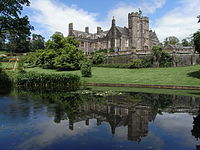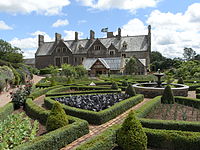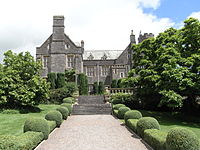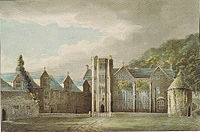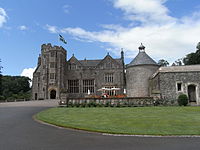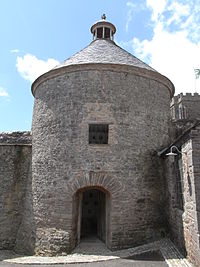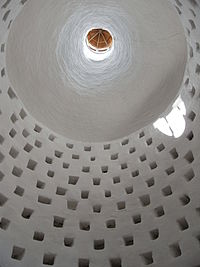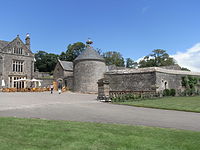Difference between revisions of "Holcombe Court"
(Created page with "{{Infobox house |name=Holcombe Court |county=Devon |picture=HolcombeCourtHolcombeRogusDevon.jpg |picture caption=Holcombe Court, in Holcombe Rogus |os grid ref=ST05561903 |lat...") |
(No difference)
|
Latest revision as of 18:46, 26 June 2018
| Holcombe Court | |
| Devon | |
|---|---|
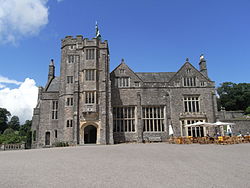 Holcombe Court, in Holcombe Rogus | |
| Location | |
| Grid reference: | ST05561903 |
| Location: | 50°57’46"N, 3°20’46"W |
| Village: | Holcombe Rogus |
| History | |
| Built c. 1540 | |
| For: | Sir Roger Bluett |
| Country house | |
| Information | |
Holcombe Court is a grand country house in the parish of Holcombe Rogus in Devon. The present Tudor manor house was built by Sir Roger Bluett around 1540[1] and was owned by the Bluett family until 1858 when Peter Frederick Bluett sold the estate to Rev. William Rayer, Rector of Tidcombe near Tiverton.[2]
The house stands immediately to the west of the parish church. The gardens and grounds are screened off from the public road at the south by a high wall in which is a tall and broad entrance archway which forms the start of the entrance drive.
The house is a Grade I listed building.[3]
Contents
Description
The south entrance front was described by Pevsner as "the most spectacular example of the Tudor style in Devon".[4]
The front porch is entered through a four-centred arch above which is a three-storey bay-window protruding and supported by corbels. The porch is surmounted by a massive buttressed tower with a staircase turret on its west (left) side. The front door opens into the screens passage]] which in its west side has not only the usual three doorways leading originally to buttery kitchen and pantry but also a fourth leading to the stair turret.
The Great Hall stands to the east (right) of the entrance, with two tall six-lighted windows with single transoms. The roof-space was subsequently ceiled to form a 65-foot long gallery above, said by Pevsner to be the best example from the 16th century in Devon. On its plaster ceiling survive the initials of the builder Sir Roger Bluett (d.1566), which makes it the earliest datable plaster ceiling in Devon.[5]
The north and west ranges were added or rebuilt in the Victorian age, c. 1859-68 by Rev. W. Rayer to the design of John Hayward. A prominent feature of the south aspect of the house is the large circular dovecote on the east (right) side, further east of which is the stable court yard
History
The manor of Holcombe Rogus had been acquired by the Bluett family in the early 15th century following the marriage of Sir John Bluett lord of the manor of neighbouring Greenham Barton and Cothay Manor, both in Somerset, about a mile and a half north-east of Holcombe Rogus, to Maude Chiseldon, daughter and co-heiress of John Chiseldon of Holcombe Rogus. Cothay Manor (two and a half miles to the north-east), was rebuilt in 1481 by Richard Bluett, and the Manor of Kittisford was later added to the Bluett estates.
Visit by Swete
The Devon topographer the Rev. John Swete (1752–1821) visited Holcombe Court as part of his travels in June 1800, and recorded the following in his journal:[6]
I had before me full in view a very picturesque scene formed by the village of Holcombe Rogus, its church and castellated mansion, long a seat and residence of the Bluets. This latter I found nearly at the head of the village street, contiguous to the church and to the vicarage house, a most magnificant antient edifice, of considerable extent and altogether such a pile (considering it the mansion of a private family) as is not to be parallel'd in the county...These, by alliances with other families of note and opulence and by producing from their own stock several scyons of worth and eminence, raised their name into high esteem among the gentlemen of the county during a long continued period of ten generations and if an inference may be allowed to be drawn from the great size of the hall, "la grande sale a manger", displayed often their hospitality to their tenantry and neighbours. The present hall, ornamented with carved work and painted glass, is not coaeval with the tower of entrance (which perhaps is the most antient part) but was erected about the middle of the sixteenth century by Sir Roger Bluet, Kt., as is supposed from his name being there visible! The proprietor of the mansion is Peter Bluett, I know not whether of this family of Holcombe Rogus, but adopted by the late proprietor, from Falmouth in Cornwall and invested with the major part of the landed property which he had possessed. Mr Polwhele passed an encomium on this Gentm., hypothetical it is true, but suppositions are not unfrequently raised on plausible tho' fallacious foundations, and the less a man commits himself on this score, fewer will be the impeachments levelled against his sagacity and judgement!!! I have no encomium to pass but from the information of Mr Drewe of Grange, that there were reports circulating that much of the fine wood behind the house was to be converted into cash and that the mansion itself was to be let ( since advertised) and from the apparent neglect of the fine old edifice "quaeque egomet ipse vidi" and the solitude by which it was encompast, I have to regret that not more of the estimable qualities and hereditary principles of the antient stock had, with the estates, been transmitted to this scyon of adoption. Within the gateway, which with surrounding walls inclosed a green area before the house, during the whole of the time in which I was taking the preceding view, I saw no living creature (tho' I understood it was inhabited by the family) but a flock of geese depasturing on the scanty herbage and a number of greyhounds basking themselves in the sun stretched out on the low wall. By the cackling of the one and the barking of the other as soon as I made my entre within the gate, I was at first a good deal annoyed...
Swete, as was often his habit, then diverted to the classical world and continued to muse for a couple of pages upon the geese which saved the capitol at Rome and the greyhound described by Ovid, and on the attitude of the ancient Romans towards both these species, finally recovering himself thus:
From this lusorium of the dogs and geese whom I left at their several occupations, I return to the mansion merely to observe that its walls are formed from the marble quarries with which this parish abounds and that in the front towards the west the same injudicious alteration in the form of the windows has taken place, 'tis may be remarked of the principal one in the sketch the Gothic style having been converted to the Grecian and the antient mullion modernised to the trim sash!! In the church as might be expected are to be found a number of monuments in honour of the family of Bluett, many of them of considerable beauty and magnificance and one in particular of white marble of John Bluett Esq. and his wife Elizth. daughter of Sir Jn. Portman Bart., whose effigies are in a recumbent posture surrounded by eight daughters kneeling. The road winding round the house ascended immediately a steepish hill giving me a view of the garden which it skirted and of the noble hanging wood that defended it from the northern blasts. Notwithstanding however the contiguity of this road to a gentleman's place of residence and to lime rocks, the chippings of whose stones must necessarily afford abundant materials for its repair, it was so rugged and full of ruts as to render it, in addition to the steepness of its acclivity, extremely incommodious to the traveller.
Swete then headed for Hockworthy.
Outside links
References
- ↑ Brooke-Webb, p.6
- ↑ Brooke-Webb, p.8
- ↑ {{NHLE|@|Holcombe House
- ↑ Nikolaus Pevsner: The Buildings of England: Devon, 1952; 1989 Penguin Books ISBN 978-0-300-09596-8page 487
- ↑ Pevsner, p.489
- ↑ Gray, Todd & Rowe, Margery (Eds.), Travels in Georgian Devon: The Illustrated Journals of the Reverend John Swete, 1789-1800, vol.4, Tiverton, 1999, pp.196-9
- Nikolaus Pevsner: The Buildings of England: Devon, 1952; 1989 Penguin Books ISBN 978-0-300-09596-8
- Pole, Sir William (d.1635), Collections Towards a Description of the County of Devon, Sir John-William de la Pole (ed.), London, 1791, p. 208, "Holcomb"
- Risdon, Tristram (d.1640), Survey of Devon, 1811 edition, London, 1811, with 1810 Additions [1]
Further reading
- Laws, Peter, A Cornish Family: Blewett of Colan
- Descendants of Walter "The Viking" Blewett
